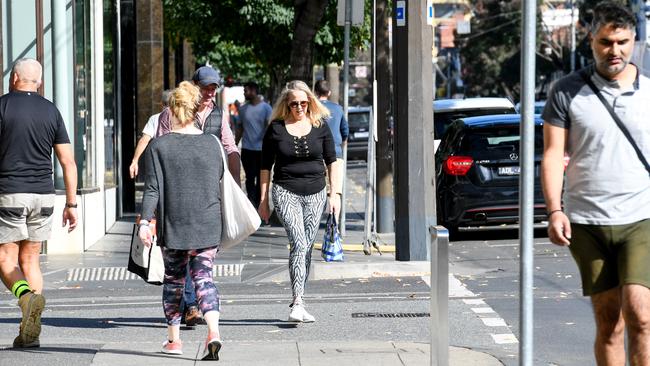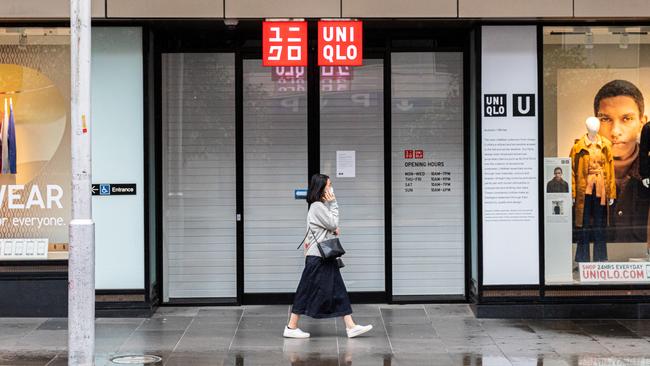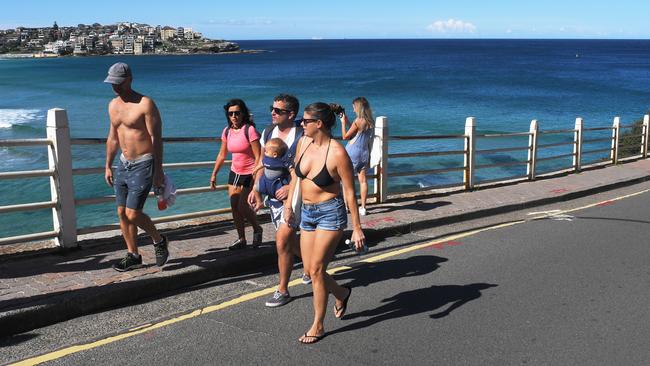The decision Australia needs to make on how we end the coronavirus epidemic
Now that Australia appears to have got the coronavirus under control, it faces an even more disturbing choice on how to end the epidemic.
National
Don't miss out on the headlines from National. Followed categories will be added to My News.
Australia appears to have brought coronavirus infections under control but is now faced with a disturbing choice on how to end the epidemic.
While some have been reluctant to claim victory against COVID-19 just yet as the true extent of community transmissions is not known, University of Melbourne epidemiologist Tony Blakely believes Australia does have the infection under control and has bought itself time to consider what the next steps should be.
In his opinion, Australia has three choices and each of these come with potentially serious consequences.
In order for Australian life to return to normal, there are only two ways that the virus can be defeated, either a vaccine is found or Australia develops “herd immunity” which means about 60 per cent of the population, or 15 million people, need to be infected.
So we can either wait it out for up to 18 months and hope the vaccine is developed quickly, or we can slowly infect Australians, knowing that some people will die.
“This is going to be brutal,” Prof Blakely said of the decision facing Australians.
While there are some “grey areas” between the options where hybrid solutions could be implemented, Prof Blakely believes there are only three main options and all of them could have serious implications for people’s lives.
“We need to be able to talk about this calmly and rationally,” he said.
“It’s a wicked choice we need to make. COVID-19 has the ‘dread factor’. It strikes older people down and they die, and occasionally it also strikes young people down.”
RELATED: Latest coronavirus updates
RELATED: Coronavirus death toll in Australia rises to 41
Prof Blakely believes it’s time for a public discussion on the path Australia should be taking and this should involve not just politicians but also epidemiologists, economists, philosophers and ethicists.
“Now that we have really good suppression of the virus, we have the opportunity for discussion and to work our way through which option we want to take,” Prof Blakely said.
While there has been little parliamentary oversight of the Morrison Government’s actions so far because of the speed at which it’s needed to act, Prof Blakely believes this should now be restored and over the next two to three weeks, the government should also engage the community through things like citizen juries, to make a decision.
Today, the Morrison Government will release its epidemic modelling and Prof Blakely believes this will also shed light on the options and the best way forward.
“Australia is truly the Lucky Country … we have created a window for discussion as we are actually now in control of the epidemic,” he said.
“Whatever we do, we should do it as a social collective, and make a decision on how we respond.
“This is the most important decision Australia’s had to make since World War II.”
OPTION 1: ELIMINATE THE VIRUS
Prof Blakely is sceptical about whether this can still be done, however, he doesn’t want to rule it out yet. Government modelling should shed light on whether it’s still possible.
The aim would be to eliminate the virus from Australia but this would involve even stricter lockdowns being enforced for between six weeks to three months.
RELATED: Aussie think tank slammed after calling for end to lockdown

Prof Blakely said people would not be allowed to leave their neighbourhoods, even for exercise or shopping. This would help contain infections to smaller areas and make it easier for authorities to track.
Construction sites and other selected activities that are currently continuing would have to be shut down.
The lockdown would also have to be longer than the two-week incubation period of the coronavirus to ensure it’s definitely been eradicated.
Prof Blakely illustrated why the virus could linger for a lot longer than two weeks.
For example, someone who got the virus might not have symptoms for seven days. Then they are infectious for another 10 days. Within those 10 days, another member of the household could contract the virus but also not show symptoms for seven days. They would also be infectious for another 10 days. That’s a total of 34 days and many households have a lot more than two people.
Any sign of infection would have to be squashed immediately and there would have to be full contract tracing for 18 months until a vaccine is available.
Australia would also have to keep its borders closed to prevent any new infections coming in.
Prof Blakely said his gut feeling was that it was too late to try this option.
“No matter how hard you try, things like Uber Eats and other essential services would see infections spread between neighbourhoods,” he said.
Pros: Lockdown could be lifted after three months.
Cons: The lockdown would be very restrictive. People would not be able to leave their neighbourhoods and more businesses would have to shut. Australia would have to keep its borders closed until a vaccine is found. If there were any remaining infections, cases could begin to rise again.
OPTION 2: SQUASH THE CURVE
This is similar to what Australia is already doing and it has been extremely successful in bringing down the numbers of new cases. If we continue with this approach, only about 2-5 per cent of Australians would be infected with COVID-19.
But the problem is, Australians would not be able to come out of lockdown until a vaccine is developed and this may not happen for 18 months. Many Aussies would not be happy with having to spend more than a year at home, and the economy may not be able to cope with this either.
Prof Blakely said it may be possible for Australia to loosen restrictions but it would be a “trial and error” process as once rules were eased, infections would begin to rise again and so future lockdowns were likely.
RELATED: Why 80 per cent of Australians need to stay home

This pattern of easing restrictions, then tightening them again once infections rose, could go on for 18 months.
Prof Blakely said this option could prevent an estimated 25,000 deaths but would require Australians to endure a radically different lifestyle until a vaccine could be found.
One of the unintended consequences of this approach may be deaths from other causes may rise.
People on elective surgery lists for example would have their operations for things like hip replacements delayed and could see a deterioration in their quality of life. There could be deaths related to domestic violence and mental illness caused by the rising unemployment rate.
“Many of us are concerned and are crunching the numbers to work out the death toll for squashing the curve … and it could be just as bad as for COVID-19,” he said.
One other option that some experts have suggested, is that the virus could be kept under control through rigorous testing.
Prof Blakely said this may be true but his gut feeling was Australia did not have the resources to achieve that. The government modelling may be able to provide a better idea of this.
Pros: It’s not a full lockdown and could save 25,000 lives.
Cons: Australians would have to be in lockdown (in some shape or form) for 18 months until a vaccine is developed. Deaths from other causes may rise. It might destroy the economy.
OPTION 3: FLATTENING THE CURVE TO HERD IMMUNITY
Prof Blakely believes the quickest way for Australians to get back to their old way of living is to “flatten the curve to herd immunity”.
Herd immunity has got a bad rap lately but apart from developing a vaccine, it’s the only other way to defeat the virus.
This option would still involve some form of lockdown for six months but the time frame could vary depending on how risky governments were prepared to be.
Essentially, infections would be allowed to rise in a controlled way, until about 60 per cent of the population had coronavirus, at which point there would be “herd immunity” and it would be much harder for the virus to spread.
Prof Blakely said even though young people could also die from the disease, those who were dying from COVID-19 were mostly the elderly and they were likely already in reasonably bad health.
He said one option was for young people to “take one for the team” and return to work as they have a low chance of developing a serious illness.
RELATED: What a full lockdown would mean and how we can avoid it

The virus would circulate and in one week’s time authorities could start to see how many new infections there were and to estimate how many people might need intensive care in another two weeks time. This would enable them to tighten restrictions again if they were seeing too many infections that might overwhelm the health system.
Those who did get sick would receive the best health care possible.
“If you manage the virus in this way, you could develop herd immunity in six months,” Prof Blakely said.
Prof Blakely said COVID-19 could claim the lives of an estimated 135,000 Australians if it was allowed to spread but he believes this number could be brought down to as low as 30,000 people if measures were taken to protect the vulnerable – including the elderly and those with underlying health conditions who would continue to stay in lockdown– and new medication or treatments were found.
“We’ve lost perspective on this,” Prof Blakely said. “About 20,000 a year die from an epidemic called tobacco.”
Pros: Australia could have herd immunity in six months time and life could return to normal.
Cons: Young and healthy people would have to be prepared to be infected with the virus. About 15 million Australians would have to be infected to achieve herd immunity and an estimated 30,000 would die even under a best-case scenario.
Which option do you think Australia should take? Comment below or continue the conversation @charischang2 | charis.chang@news.com.au
Originally published as The decision Australia needs to make on how we end the coronavirus epidemic



